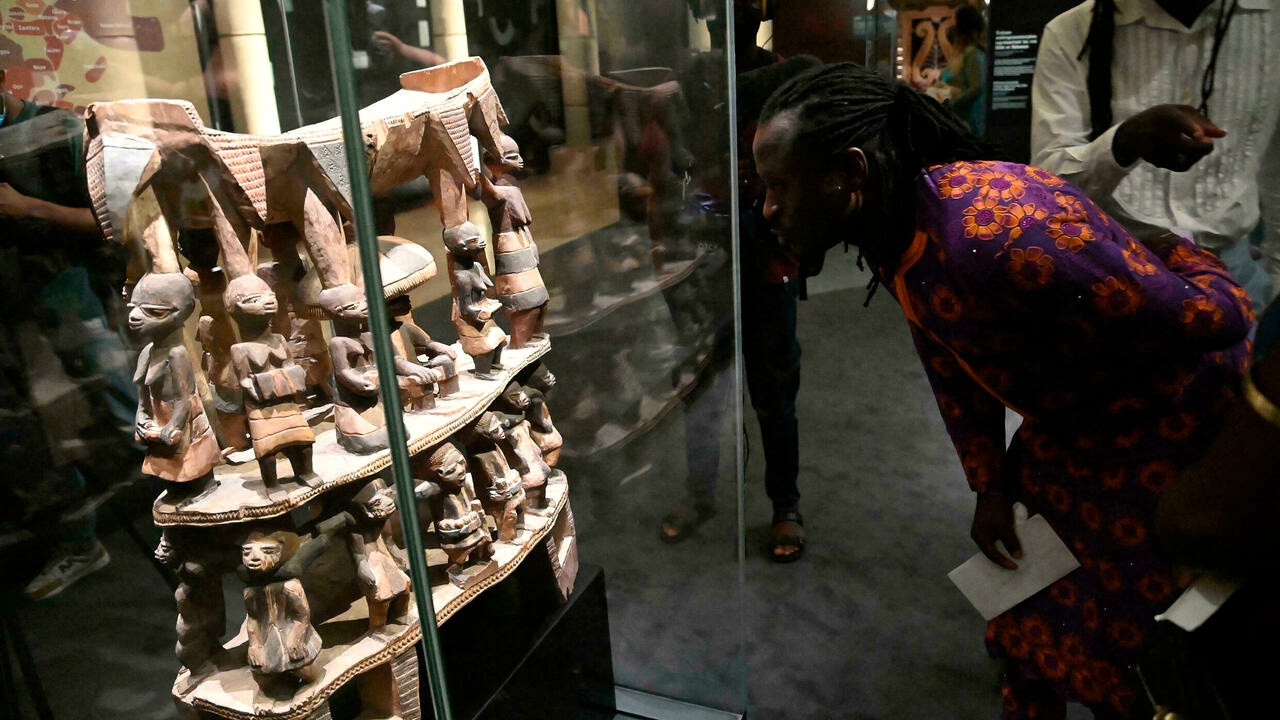
A man looks at Cana throne, displayed at an exhibition entitled "Benin Art Yesterday and Today" on February 18, 2022. /AFP
A man looks at Cana throne, displayed at an exhibition entitled "Benin Art Yesterday and Today" on February 18, 2022. /AFP
Benin President Patrice Talon on Saturday inaugurated an exhibition of historic treasures returned by France last year, nearly 130 years after they were stolen by colonial forces.
The 26 pieces, some considered sacred in Benin, will be displayed from Sunday in a 2,000-square-meter space in the presidential palace in Cotonou in a show entitled "Benin Art Yesterday and Today".
The return of artefacts by France comes as calls grow in Africa for Western countries to hand back colonial spoils from their museums and private collections.
Britain, Belgium, the Netherlands and Germany have all received requests from African countries to return lost treasures.
The 26 pieces returned in November after two years of negotiations between Paris and Cotonou, were stolen in 1892 by French colonial forces from Abomey, capital of the former Dahomey kingdom located in south of modern-day Benin.
This exhibition equals "pride and faith in what we once were, in what we are and in what we will be," Talon told reporters.
That the exhibits were finally returning home had broken a taboo and paved the way for more such repatriations, he argued. "We did it," he said.
Benin Culture Minister Jean-Michel Abimbola earlier told AFP the exhibition was "returning to the Benin people as part of their soul, part of their history and their dignity."
The objects "were taken from a kingdom, but they are returning to a republic," he said.
Before its unification Benin was made up of several kingdoms, including Dahomey, which was known for its vibrant artistic culture.
In the first room of the exhibition, immense black walls form the backdrop for a display of the thrones of Dahomey, including the wood and metal sculpture throne of king Ghezo.
"Since it was installed, I haven't stopped contemplating it," said Theo Atrokpo, one of the exhibition guides.
"I had already seen it in the Quai Branly museum in France, but to see it here, home with us, it brings back part of our soul and connects with our history."
President Talon, who was to inaugurate the event on Saturday evening, presented the exhibition to France's Culture Minister Roselyne Bachelot before the official opening.
"It's a magnificent exhibition which brings out the majesty, creativity, and the incredible historic, political and esthetic patrimony that these 26 artefacts represent," said the minister.
Alongside the royal treasures, the works of 34 contemporary artists have been selected for the exhibition.
"It's very emotional to be in front of this throne," said Laeila Adjovi, a French-Benin artist whose work forms part of the exhibition.
"But I never imagined it would be so large."
French President Emmanuel Macron has worked to restore African heritage and Benin's culture minister said discussions were ongoing to return other objects, including the sculpture of the god Gou, which is in the Louvre Museum in Paris.
French lawmakers have passed a bill allowing Paris to return artefacts to both Benin and Senegal, another former French colony.
Some were seized by colonial administrators, troops or doctors and passed down to descendants who in turn donated them to museums in Europe and the United States.
But others were gifts to missionaries or acquired by African art collectors at the start of the 20th century or discovered by scientific expeditions.
A report commissioned by Macron counted some 90,000 African works in French museums, 70,000 of them at the Quai Branly alone.
"The work of restitution continues," said French minister Bachelot. "We are working on a law that will help facilitate this restitution."
Source(s): AFP

